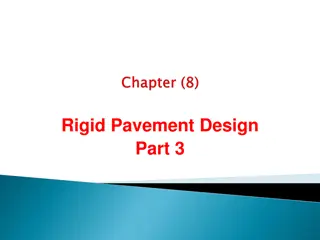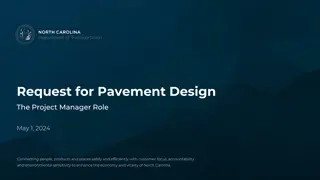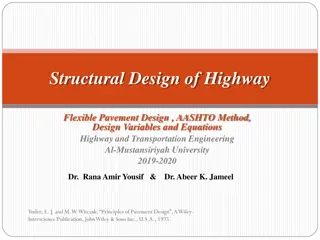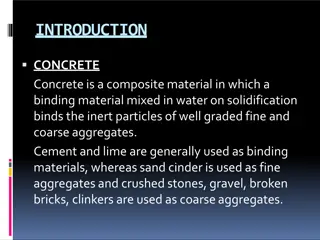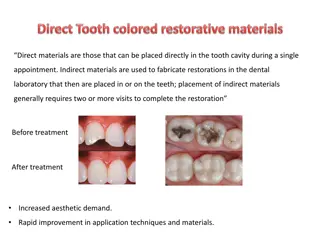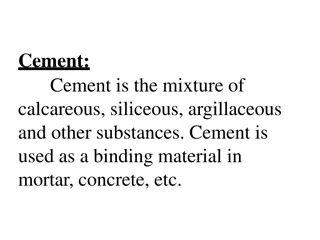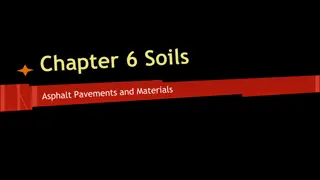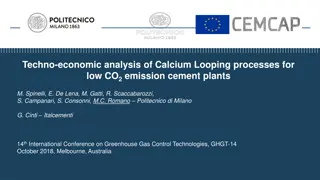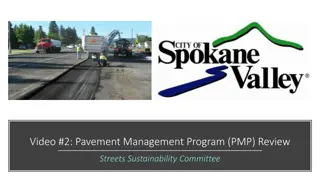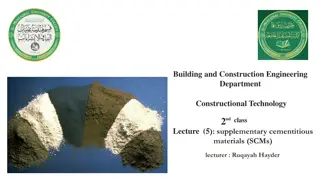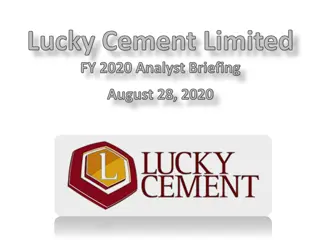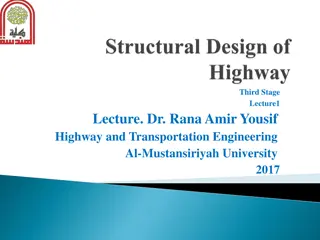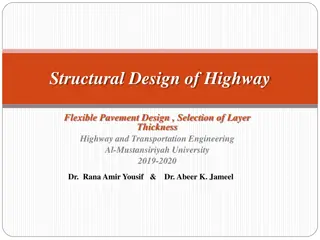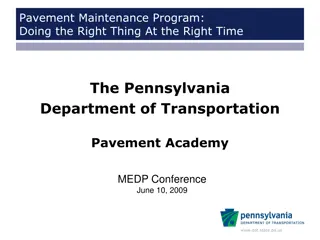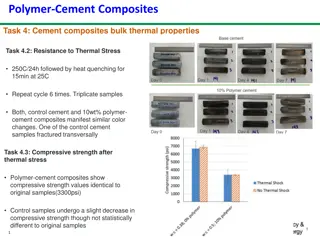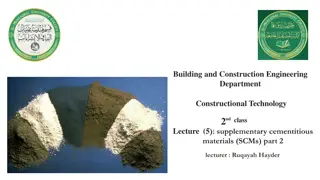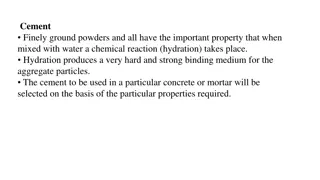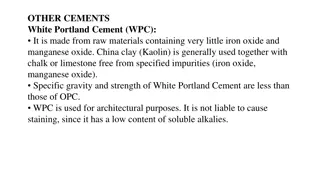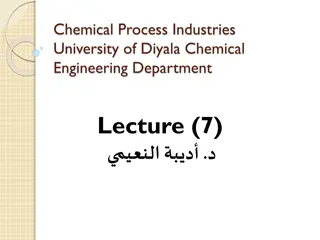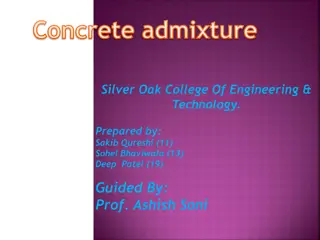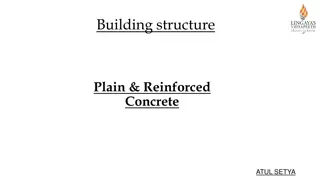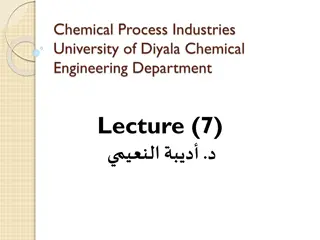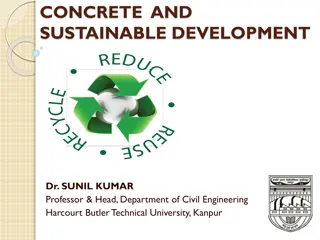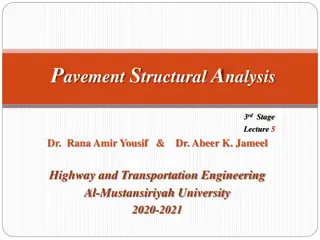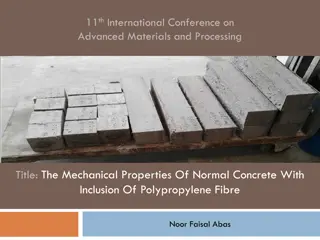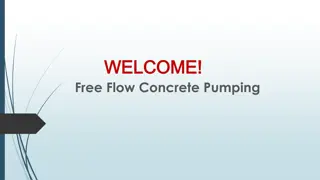Information on Cement and Leading Cement Companies in Indonesia
Cement plays a crucial role in binding building materials together. Learn about the definition of cement, the history of cement production, and prominent cement companies in Indonesia like Semen Indonesia, PT Cemindo Gemilang, and Holcim Indonesia.
4 views • 74 slides
Rigid Pavement Design: Stresses and Joint Types
Stresses due to temperature variation can affect concrete slabs, causing warping and friction stresses. Proper joint design, including expansion, contraction, and construction joints, is crucial to minimize stress and prevent warping in concrete pavements. This guide explores different types of join
4 views • 9 slides
Request for Pavement Design
Seeking Pavement Design services in North Carolina for safe and efficient connectivity. Requests for designs go to Shihai Zhang, with specific criteria for projects to go through the Pavement Review Committee. Information needed includes project details, traffic data, and plans.
0 views • 4 slides
Best Concrete Flooring in Koputaroa
If you\u2019re looking for Concrete Flooring in Koputaroa, contact Sharp N Ready Concrete. They specialize in providing high-quality concrete solutions for both residential and commercial projects. From concrete driveways, concrete flooring, and concrete patios to foundations and retaining walls, th
0 views • 6 slides
If you are looking for Concrete Contractor in Mauku
If you are looking for Concrete Contractor in Mauku, LDH Concrete and Excavations is your trusted partner for all concrete and excavation needs. With over 10 years of experience, we serve Patumahoe and the entire Auckland region. Our team of expert concrete layers and excavators can assist you with
0 views • 6 slides
AASHTO Method for Highway Flexible Pavement Design
The AASHTO method for highway flexible pavement design is based on the AASHO Road Test results and has been revised over the years to provide guidelines for pavement structural design. It emphasizes performance period, time constraints, and design variables to ensure long-lasting and cost-effective
1 views • 25 slides
Understanding Concrete: Types, Uses, and Classification
Concrete is a composite material composed of binding materials, water, and inert particles. It is classified based on binding materials, design, and purpose. Cement concrete is widely used in construction for its strength and durability, while lime concrete offers an economical alternative where cem
1 views • 48 slides
Concrete Mix Design: Optimal Proportions & Aggregate Gradation
Concrete mix design is crucial for achieving the desired properties and performance of concrete. The Maximum Aggregate Density Mix Design method helps determine the best proportions for Portland Cement Concrete. Utilizing combined aggregate gradation near the maximum density line can reduce shrinkag
0 views • 34 slides
Evolution of Dental Restorative Materials: From Silicate Cement to Composite Resins
Various dental restorative materials have evolved over the years, from silicate cement to composite resins. Silicate cement, introduced in 1871, offered advantages like matching tooth color but had drawbacks such as dental pulp irritation. Unfilled acrylic polymers, developed around 1945, showed imp
2 views • 11 slides
Guidelines for Design of Cement Concrete Pavement and Interlocking Paver Blocks
This document provides guidelines for designing cement concrete pavements and interlocking paver blocks, covering factors governing design, wheel loads, design period, subgrade characteristics, approximate k values based on CBR values, and the importance of a sub-base below concrete pavements. It em
0 views • 67 slides
Overview of Cement: Types, Composition, and Functions
Cement is a vital building material consisting of various compounds like lime, silica, and alumina. It is used in mortar and concrete. The chemical composition of cement includes elements like iron oxide and gypsum. Different types of cement serve specific purposes such as rapid hardening or sulfate
0 views • 29 slides
Understanding Asphalt Binders in Pavement Construction
Asphalt binders play a crucial role in pavement construction, composed of three types of hydrocarbons: asphaltenes, resins, and oils. Different types of asphalt cements are produced for specific applications, such as liquid asphalts and asphalt emulsions. Quality control tests ensure the performance
0 views • 16 slides
Techno-Economic Analysis of Calcium Looping Processes for Low CO2 Emission Cement Plants
This study explores the application of Calcium Looping (CaL) processes in cement plants to reduce CO2 emissions. The process involves using CaO as a sorbent to capture CO2 from flue gas, with the potential for integration at different points in the cement production process. The Tail-end CaL configu
3 views • 14 slides
Understanding Pavement Management Programs: A Comprehensive Overview
Discover the intricacies of a Pavement Management Program (PMP) through a detailed review presented to the Streets Sustainability Committee. Explore the historical practices, recent advancements, and key elements of the City's PMP. Learn about 450 centerline miles, street classifications, budget con
0 views • 28 slides
Sustainable Building Practices: Using Supplementary Cementitious Materials
Supplementary Cementitious Materials (SCMs) are waste and by-product materials that can be used as full or partial substitutes for cement in concrete production. This practice helps reduce the environmental impact of traditional cement manufacturing processes and improves the overall sustainability
0 views • 18 slides
Lucky Cement Limited FY 2020 Analyst Briefing Highlights
Lucky Cement Limited's FY 2020 Analyst Briefing highlights key figures, such as revenue growth, operating profit reduction, and sales quantity in the cement sector. Despite challenges like COVID-19, the company shows resilience with strategic investments and developments.
3 views • 13 slides
- "Development of Pavement-Specific Structural Synthetic Fibers - TAP Meeting Insights
- The TAP meeting on the development of pavement-specific structural synthetic fibers held on November 3, 2021, highlighted key benefits of fibers in pavements, such as increased load transfer efficiency and reduced cracking. Various industry partners and experts discussed the participation of fiber
0 views • 42 slides
Influence of Seasonal Temperature on Pavement Reliability Performance: A Case Study
This case study explores the impact of seasonal temperature changes on pavement reliability performance (PRP) by analyzing crash and pavement data for three pavement types in a U.S. State, delving into how temperature affects asphalt properties and friction levels. The study compares crash trends fo
0 views • 26 slides
Pavement Engineering Overview: Types, Design, and Requirements
A comprehensive overview of highway pavement engineering, covering types of pavements, structural requirements, ideal pavement characteristics, and classifications into flexible, rigid, and composite pavements. Proper pavement design is crucial for ensuring long-lasting, safe, and high-quality road
0 views • 19 slides
Introduction to Rigid Pavement Design in Highway Engineering
Rigid pavements, made of cement or reinforced concrete slabs, are designed to resist traffic loads by distributing them over a wide area of soil. The design focuses on providing a structurally strong concrete slab. Minor variations in subgrade strength have little impact on rigid pavement capacity,
0 views • 13 slides
Selection of Layer Thickness in Highway Flexible Pavement Design
Selection of layer thickness for highway flexible pavement design involves determining an initial pavement structure's design structural number and then choosing appropriate thicknesses to meet or exceed the required structural number. Cost-effectiveness, construction constraints, and maintenance co
0 views • 11 slides
Recycled Asphalt Pavement and Recycled Concrete Aggregate: Survey Report
This survey report explores the production and properties of Recycled Asphalt Pavement (RAP) and Recycled Concrete Aggregate (RCA). It discusses the materials, nomenclature ambiguity, and physical properties of RAP and RCA, shedding light on their production methods, mechanical and physical characte
0 views • 42 slides
Concrete Pavement Repair and Replacement Techniques
Explore different bid items and techniques used for concrete pavement repair and replacement, including base patching with Type B and Type C Family Concretes, consolidation methods, surface finishing options, and key similarities and differences between various materials. Gain insights into contract
0 views • 14 slides
Effective Pavement Management Program Overview
This program by the Pennsylvania Department of Transportation focuses on the importance of implementing preventive maintenance strategies at the right time for highway pavement management. It covers topics such as types of pavements, preventive maintenance concepts, treatment selection, and timing f
0 views • 14 slides
Impregnation of Asbestos Cement Sheeting with Polyurethane Binder
The report discusses the successful impregnation of asbestos cement sheeting with a polyurethane binder to bond and reinforce the material. Through a method involving dye adduct formation and optimization of impregnation levels, the exposed asbestos fiber was effectively bonded. The process ensures
0 views • 6 slides
Well Cementing Procedures in Oil and Gas Industry
Learn about the important procedures involved in well cementing for remedial repair, cement squeezing at different pressures, packer operations, and water loss control using low water loss cement. Understand the steps involved in pump cementing under pressure, successful high-pressure squeezes, and
0 views • 23 slides
Study on the Thermal and Chemical Properties of Polymer-Cement Composites
The study investigates the resistance of polymer-cement composites to thermal stress and chemical attacks such as acidic and high CO2 environments. Results show similar color changes in control cement and polymer-cement composites after thermal stress, with the latter maintaining compressive strengt
0 views • 5 slides
Understanding GGBS in Concrete Technology
Ground Granulated Blast Slag (GGBS) is a popular supplementary cementitious material used in concrete production, derived from blast-furnace slag. The production process involves rapid quenching of molten slag with water. GGBS concrete offers advantages like improved workability, reduced water deman
0 views • 15 slides
Understanding Different Types of Cement for Construction
Cement is a crucial component in concrete and mortar, with various types available based on specific project requirements. Types include Ordinary Portland Cement for general construction, Modified Portland Cement for sulfate resistance, High Early Strength Cement for quick setting, Low Heat Portland
0 views • 5 slides
Saveh Cement Company: Business Plan Presentation Overview
Saveh Cement Company, a leading cement producer and exporter in Iran, aims to enhance energy efficiency, increase production rates, and reduce CO2 emissions through innovative projects. Established in 1988, the company boasts a strong market presence, high-quality products, and international certifi
0 views • 9 slides
Understanding Different Types of Cement
White Portland Cement (WPC) is ideal for architectural use due to its low iron and manganese oxide content, while High Alumina Cement (HAC) offers rapid hardening and sulfate resistance. Portland Pozzolan Cement provides greater sulfate attack resistance and is suitable for marine and hydraulic cons
0 views • 5 slides
Overview of Cement Industry: Processes and Classification
The lecture from the Chemical Engineering Department at the University of Diyala delves into the chemical process industries, focusing on the Cement Industry. It covers the properties of cement, raw materials required, the process of making concrete using Portland cement, and the classification of v
0 views • 10 slides
Understanding Concrete Admixtures for Improved Performance
Chemical admixtures play a crucial role in enhancing the quality and durability of concrete construction. They help in modifying concrete properties, reducing costs, and ensuring consistent quality during various stages of concrete operations. Air-entraining admixtures improve concrete durability ag
0 views • 17 slides
Understanding Plain & Reinforced Concrete Structures
Concrete is a vital construction material, with Plain Cement Concrete (PCC) and Reinforced Cement Concrete (RCC) being common types. PCC lacks reinforcement and is strong in compression but weak in tension. On the other hand, RCC combines concrete with steel reinforcement for improved tensile streng
0 views • 10 slides
Evolution of Concrete in the Chemical Process Industries
Cement and concrete have a rich history dating back thousands of years. Cement was used by ancient civilizations like the Egyptians, Assyrians, Babylonians, and Romans. Concrete, which is a mixture of aggregates bonded by cement and water, revolutionized architecture during the Roman Empire. The int
0 views • 12 slides
Concrete and Sustainable Development in Civil Engineering by Dr. Sunil Kumar
Dr. Sunil Kumar from Harcourt Butler Technical University, Kanpur, discusses concrete as a conglomerate rock with large aggregate particles in a paste matrix. Sustainable development involves remedying past mistakes, avoiding pollution, and balancing development with environmental preservation. The
0 views • 17 slides
Nonlinear Analysis of Pavement Structural Stresses and Deflections
Explore the effect of nonlinearity in granular materials on vertical stresses and deflections in pavement structural analysis. Learn about iterative methods and stress invariants to understand pavement behavior under traffic loads. Discover the application of Boussinesq's solutions and Burmister's l
0 views • 20 slides
Mechanical Properties of Concrete with Polypropylene Fibre Inclusion
Concrete is a brittle material that is strong in compression but weak in tension. In this study, the focus is on enhancing the mechanical properties of normal concrete by including polypropylene fibers. The inclusion of fibers helps improve crack resistance and flexural strength, acting as crack arr
0 views • 17 slides
Pavement for Cities: A Detailed Business Plan by DLS-Construction GmbH
This detailed business plan by Sascha Kindermann, Lothar Kunz, and Diana Hennings explores various aspects of pavement for cities, including calculations, advantages, disadvantages, financing, applications, and road construction. It covers the definition of pavement, its types, advantages like durab
0 views • 27 slides
Best Concrete Finishing Services in Rosebery
If you want the Best Concrete Finishing Services in Rosebery, visit Free Flow Concrete Pumping. They specialize in comprehensive concrete services, offering expertise in concrete pumping, concrete pouring, concrete finishing, concrete laying, and gen
1 views • 6 slides

